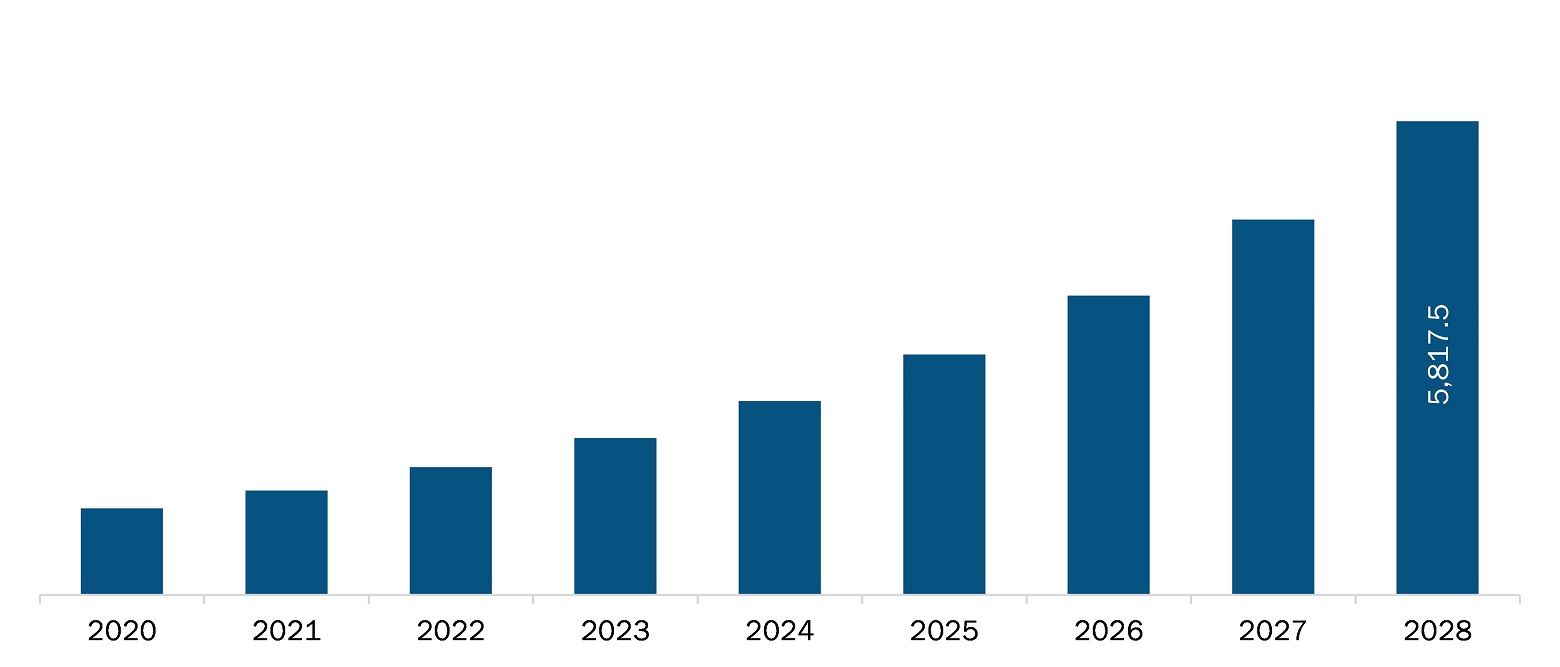The Europe vertical farming market is expected to reach US$ 5,817.5 million by 2028 from an estimated value of US$ 1,062.1 million in 2021; it is likely to grow at a CAGR of 24.1% from 2021 to 2028.
The market growth in Europe is attributed to rapid developments in precision farming technologies and the rising adoption of artificial intelligence and robotics in vertical farming. However, high initial investments and maintenance costs may hamper the growth of the Europe vertical farming market during the forecast period.
The modern farming and agriculture industry is leveraging the potential of AI. Key market players in vertical farming are monitoring the requisite environmental conditions for plant development, including soil, water, light exposure, and crop yield data. Advanced technologies, such as AI-powered tools and robotics, enable farmers and agriculturists to track and control plant development. An advanced climate-controlled vertical farming setup consists of AI-powered robots, which control water consumption, temperature, and lighting; it can produce 720 acres worth of fruit and vegetable yields in just 2 acres of farmland. Favorable conditions are being created manually with the use of LED panels to replicate sunlight for the optimal development of crops. Such innovations in modern farming that leverage the advantages of AI and robotics are anticipated to provide lucrative growth opportunities for the vertical farming market players. At present, precision agriculture technologies that include automatic steering, yield monitoring, remote sensing, in-field electronic sensors, section and row control, and spatial data management are the most popular trend in the vertical farming market. With the augmenting demand for food, farmers and agriculturists are increasingly shifting toward precision farming in a bid to improve time management, reduce water and chemical usage, improve yield, and produce healthier crops. Precision farming them to maximize their yields by tapping GPS, data analytics, and applications. Maps created from the data guide the farmers about the use of seed, water, fertilizer, and pesticide in every area. They also inform them about the suitable time to harvest. The increasing awareness and knowledge about precision farming, especially in remote areas, is likely to have a positive impact on the vertical farming market over the forecast period.
Several European countries have experienced significant rise in the spread of COVID-19. For instance, Russia, the UK, Italy, Spain, Germany, and France, among others, have recorded high number of cases. Stupendous growth in the spread of SARS-CoV-2 led the governments to undertake stringent measures to contain the spread during the first wave. The countries mentioned earlier house numerous manufacturing facilities, including vertical farming equipment manufacturing plants. In addition, the shuttering of supermarkets in several European countries in the peak times of virus spread resulted in substantial decrease in demand for equipments for farming among the retailers. The majority of the businesses in the region focused on the continuity of their operations by utilizing the existing resources (both human and technologies) rather than investing on newer technologies. However, the adoption of vertical farming products has gained traction from the first quarter of 2021. The market in Europe is also anticipated to witness significant growth due to the rise in urban agriculture as a means of addressing localized food shortages during the post-pandemic period.

- This FREE sample will include data analysis, ranging from market trends to estimates and forecasts.
EUROPE VERTICAL FARMING MARKET SEGMENTATION
By Growth Mechanism
- Hydroponics
- Aeroponics
- Aquaponics
By Component
- Lighting
- Sensor
- Climate Control
- Irrigation Component
- Building Material
- Others
By Country
- Germany
- Italy
- Russia
- France
- UK
- Rest of Europe
Company Profiles
- iFarm
- OSRAM GmbH
- Square Mile Farms
- Agrilution
Europe Vertical Farming Report Scope
| Report Attribute | Details |
|---|---|
| Market size in 2021 | US$ 1,062.1 Million |
| Market Size by 2028 | US$ 5,817.5 Million |
| CAGR (2021 - 2028) | 24.1% |
| Historical Data | 2019-2020 |
| Forecast period | 2022-2028 |
| Segments Covered |
By Growth Mechanism
|
| Regions and Countries Covered |
Europe
|
| Market leaders and key company profiles |
|
- Historical Analysis (2 Years), Base Year, Forecast (7 Years) with CAGR
- PEST and SWOT Analysis
- Market Size Value / Volume - Regional, Country
- Industry and Competitive Landscape
- Excel Dataset
Recent Reports
Testimonials
Reason to Buy
- Informed Decision-Making
- Understanding Market Dynamics
- Competitive Analysis
- Identifying Emerging Markets
- Customer Insights
- Market Forecasts
- Risk Mitigation
- Boosting Operational Efficiency
- Strategic Planning
- Investment Justification
- Tracking Industry Innovations
- Aligning with Regulatory Trends





















 Get Free Sample For
Get Free Sample For